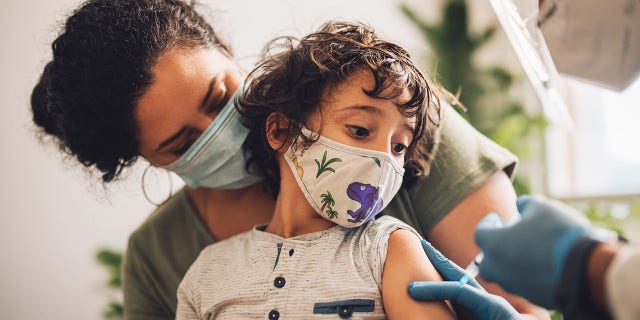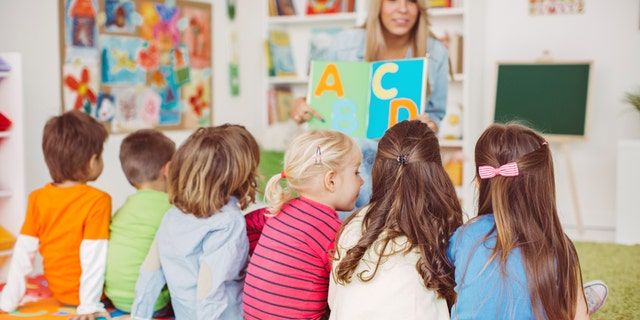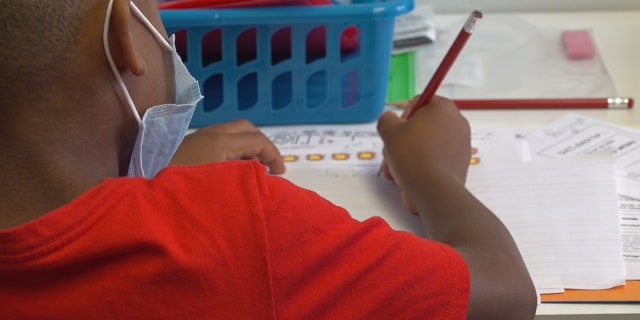Kids in the US are more than 100 times less likely to die from COVID than adults, according to a new study.
The study, published by the JAMA Network of medical journals, came after students suffered historic learning loss due to school closures during the COVID pandemic—a loss in academic progress whose effects may be felt for years to come.
Children aged 0-19 died from COVID at a rate of 1 per 100,000 from August 2021 through July 2022, the study found. There were 821 COVID deaths—meaning cases when COVID was the underlying cause of death—for this age range during the 12-month period.
Specifically, COVID death rates in infants younger than 1 year were 4.3 deaths per 100,000, 0.6 per 100,000 in children aged 1 to 4 years, 0.4 per 100,000 in children aged 5 to 9 years, 0.5 per 100,000 in children aged 10 to 10 and 1.8 per 100,000 in those aged 15 to 19 years.
Dr. Anthony Fauci accusing the GOP of “character assassination” masquerading as oversight. (Getty Images)
FAUCI SAYS SCHOOL CLOSURES LED TO ‘DELETERIOUS COLLATERAL CONSEQUENCES,’ BUT HE HAD ‘NOTHING TO DO’ WITH IT
By comparison, there were more than 360,000 total COVID deaths in the US at this time. This means, according to the study, that people died from COVID at a rate of 109 per 100,000, making kids more than a hundred times less likely to die from the virus than adults.
Meanwhile, the Johns Hopkins Coronavirus Resource Center released data on Sunday showing COVID has led to 337 deaths per 100,000 people in the US The JAWA study used different methodology than Johns Hopkins, but both datasets suggest COVID is much less deadly for kids than for the overall population.
This suggestion was bolstered by the Centers for Disease Control and Prevention, which last week released data showing children account for less than 0.15% of all COVID deaths.
Still, COVID ranked eighth among all causes of death for children and young people aged 0 to 19 in the US and fifth in disease-related causes of deaths — excluding unintentional injuries, assault, and suicide.
Unintentional injuries accounted for 18.4% of child deaths and 6.8% were from suicide, according to the JAWA Network study. About 6.9% were from assault.

CDC data shows that the vaccine reduces the small risk that children could develop severe disease from the virus. (iStock)
US MATH, READING TEST SCORES PLUNGE FOR STUDENTS ACROSS COUNTRY FOLLOWING COVID-19 PANDEMIC
COVID accounted for 2% of all deaths in children, meaning kids are over nine times more likely to die in an accident and over three times more likely to die from assault or suicide than from COVID.
The new study comes as students in the US are struggling to deal with the effects of learning loss suffered from school closures during the pandemic.
The Education Department’s National Assessment of Educational Progress, known as the nation’s report card, which tests a broad sampling of fourth and eighth graders, was released in October and showed the “largest score declines” since the federal government began tracking these metrics in 1990.
Math and reading scores took major hits nationwide, especially among the country’s most vulnerable students. Black and Hispanic students, for example, experienced steeper declines than white and Asian peers in fourth-grade math after already starting out behind.
Between 2019, the results of the last National Assessment of Educational Progress, and 2022, the number of black students in public schools performing “below basic” in fourth-grade math on the national assessment spiked from 35% to 46%. The share of Hispanics rose from 27% to 37%. The share of whites scoring at the lowest performance level only increased from 12% to 15%.

Teacher with a group of preschool children in a nursery. (iStock)
LEARNING LOSS FROM COVID LOCKDOWNS CAUSED ‘UNMITIGATED DISASTER’ PARTICULARLY IN STUDENT BEHAVIOR: EXPERTS
Many categories saw significant declines in academic performance across the board, regardless of race. But overall, performance gaps between white students and their black and Hispanic peers widened since 2019.
More broadly, fourth-graders who were in the bottom 25th percentile in both math and reading lost more ground compared with students at the top of their class, leaving these low-performing students further behind.
Students with less resources at home especially struggled. Only half of fourth graders who were low-performing in math said they had access to a computer at all times during the 2020-2021 school year, compared with 80% of high-performing students, according to a survey included in the assessment. Similarly, 70% of low performers said they had a quiet place to work at least some of the time, compared with 90% for high performers.
The new national figures coincided with California releasing state-specific data showing two out of three California students didn’t meet state math standards and more than half didn’t meet English standards on state assessments taken in the spring, further highlighting the toll that school Closures during the pandemic took on student learning.
The test results were more devastating for low-income and minority students. Indeed, 84% of black students and 79% of Hispanic and low-income students didn’t meet state math standards this past year.

Private tutors can cost anywhere from $20-$70 dollars an hour per kid. (iStock)
HIGH-POVERTY SCHOOL DISTRICTS SUFFERED MORE LEARNING LOSS DURING COVID PANDEMIC, ACCORDING TO STUDY
Several other data sets over the last two years have found similar results showing low-income and minority students have been hit especially hard by school closures.
As early as July 2021, McKinsey & Co., a leading consulting firm, released a report that detailed how children in low-income schools ended the school year on average seven months behind in math and six months behind in reading.
In majority Black schools, students ended the year six months behind in both math and reading on average, according to the report. Their peers in high-income and majority white schools, meanwhile, fared better, although they still lost several months of learning due to the shutdowns.
McKinsey forecast that “pandemic-related unfinished learning” could reduce lifetime earnings for K–12 students and create a potential annual GDP loss of hundreds of billions of dollars.
More recently, a Stanford University study found that students enrolled in schools during pandemic restrictions will face an average of a 2% to 9% drop in lifetime earnings, resulting in states facing a 0.6% to 2.9% drop in total GDP.

Tired business woman resting her head on desk (iStock)
PANDEMIC LEARNING LOSS COULD COST STUDENTS THOUSANDS IN INCOME OVER THEIR LIFETIME: STUDY
“At the extreme, California is estimated to have lost $1.3 trillion because of learning losses during the pandemic,” wrote the study’s author, Eric Hanushek. “These losses are permanent unless a state’s schools can get better than their pre-pandemic levels.”
Hanushek argued there’s “overwhelming evidence that students in school during the closure period and during the subsequent adjustments to the pandemic are achieving at significantly lower levels than would have been expected without the pandemic.”
The study analyzed National Assessment of Educational Progress data and found that between 2019 and 2022, test scores in math and English dropped an average of eight points across the country. The drop came after nearly two decades of progress, the study noted, erasing all the gains in test scores made between 2000 and 2019.
As early as 2020, some medical experts publicly opposed school closures, arguing COVID was significantly more deadly for the old and infirm than younger people. However, Sweden was the only major Western country to keep schools open for kids 15 and younger throughout the pandemic. The New England Journal of Medicine published an analysis of the health effects on Swedish children.
“Despite Sweden’s having kept schools and preschools open, we found a low incidence of severe COVID-19 among schoolchildren and children of preschool age during the SARS-CoV-2 pandemic,” the 2021 study stated. “Among the 1.95 million children who were 1 to 16 years of age, 15 children had Covid-19, MIS-C, or both conditions and were admitted to an ICU, which is equal to 1 child in 130,000.”
CLICK HERE TO GET THE FOX NEWS APP
The study also found that few school teachers had to receive intensive care for COVID.
In the US, schools are now open, but some are reinstituting pandemic-era protocols. Schools in Michigan and Massachusetts, for example, recently put mask mandates in place for both staff and students, following in the footsteps of districts in New Jersey and Pennsylvania.
